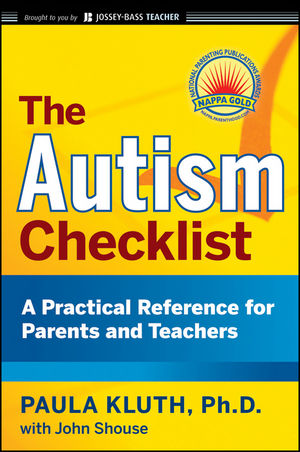The Autism Checklist: A Practical Reference for Parents and TeachersISBN: 978-0-470-43408-6
Paperback
256 pages
September 2009, Jossey-Bass
 This is a Print-on-Demand title. It will be printed specifically to fill your order. Please allow an additional 10-15 days delivery time. The book is not returnable.
|
||||||
About the Authors.
SECTION ONE: BASIC INFORMATION ON AUTISM AND ASPERGER SYNDROME.
Introduction.
1.1 What We Know About Autism.
1.2 What Do We Mean by the Autism Spectrum?
1.3 Conditions Commonly Associated with Autism.
1.4 Positive Traits Associated with Autism.
1.5 Early Indicators of Autism.
1.6 Autism Myths Versus Autism Facts.
1.7 Tools Used in Autism Screening and Diagnosis.
1.8 Social Differences.
1.9 Communication Differences.
1.10 Movement Differences.
1.11 Sensory Differences and Sensitivity.
1.12 Passions, Interests, and Rituals.
SECTION TWO: CHECKLISTS FOR PARENTS.
Introduction.
2.1 After Diagnosis.
2.2 Sharing the News.
2.3 Help for Families.
2.4 What Those on the Spectrum Need at Home.
2.5 Modifying the Home.
2.6 Safety at Home.
2.7 Safety in the Community.
2.8 Adaptations at Family Events.
2.9 Adaptations for Errands and Outings.
2.10 Adaptations While Traveling.
2.11 Helping Your Child Learn at Home
2.12 Advocating for Your Child.
SECTION THREE: CHECKLISTS FOR TEACHERS.
Introduction.
3.1 What to Do If You Think a Student is on the Spectrum.
3.2 Needs of Students with Autism.
3.3 Helpful Habits of Mind for Teachers.
3.4 Learning About Autism.
3.5 Encouraging Self-Advocacy.
3.6 Addressing Student Fascinations and Passions in the Classroom.
3.7 Supporting Students Who Seek Perfection.
3.8 Supporting Students Who Resist or Refuse to Do Work.
3.9 Helping Students Cope with Anxiety.
3.10 Building a Supportive Classroom Community.
3.11 Creating a Comfortable Classroom.
3.12 Giving Clear Directions in the Classroom.
3.13 Providing Structure in the Classroom.
3.14 Creating Lessons with Students with Autism in Mind.
3.15 Creating More Accessible Whole-Class Discussions and Lectures.
3.16 Creating Assessments Appropriate for Students with Autism.
3.17 Supports and Strategies for Literacy Lessons.
3.18 Supports and Strategies for Math Lessons.
3.19 Helping Students Manage Homework.
3.20 Making Within-School Transitions Easier for Students.
3.21 Making School-to-School Transitions Easier for Students.
3.22 Preventing Behavior Struggles in the Classroom.
3.23 Don?ts for Working with Students with Autism.
3.24 Helping Students with Autism Shine.
SECTION FOUR: MORE HELPFUL STRATEGIES FOR HOME AND SCHOOL.
Introduction.
4.1 To Keep in Mind for Toddlers and Preschoolers.
4.2. To Keep in Mind for School-Age Children.
4.3 To Keep in Mind for Adolescents and Teenagers.
4.4 Possible Members of a Support Team.
4.5 Strategies for Encouraging and Facilitating Communication.
4.6 Strategies for Supporting Those Without Reliable Communication.
4.7 Strategies for Encouraging and Supporting Social Relationships.
4.8 Strategies for Building Social Skills.
4.9 Addressing Movement Differences.
4.10 Addressing Sensory Issues: Visual.
4.11 Addressing Sensory Issues: Tactile.
4.12 Addressing Sensory Issues: Auditory.
4.13 Addressing Sensory Issues: Olfactory.
4.14 Strategies for Teaching and Learning.
4.15 Promoting and Teaching Organization.
4.16 Promoting and Teaching Stress Relief.
4.17 Helping Those on the Spectrum Cope with Change.
4.18 Addressing Challenging Behavior.
4.19 Strategies for Coping in Crisis.
SECTION FIVE: HELPFUL RESOURCES FOR PARENTS AND TEACHERS.
Introduction.
5.1 Recommended Videos.
5.2 Recommended Books.
5.3 Recommended Web Sites.
5.4 Recommended Vendors.
5.5 Recommended Organizations.
References.
Index.



